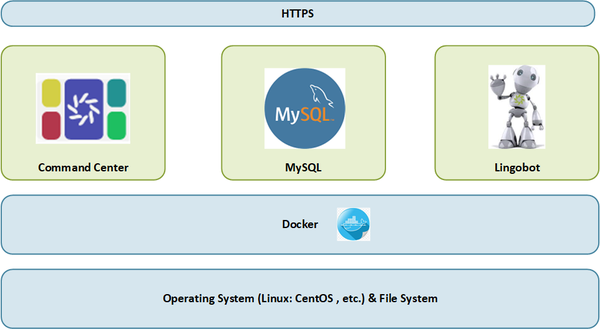Difference between revisions of "Command Center Installation"
(→New Installation) |
(→Run InstallCommmandCenter.sh) |
||
| Line 94: | Line 94: | ||
====Run InstallCommmandCenter.sh==== |
====Run InstallCommmandCenter.sh==== |
||
| − | ./InstallCommmandCenter.sh |
+ | sudo ./InstallCommmandCenter.sh |
To check the running container status |
To check the running container status |
||
Revision as of 01:08, 18 January 2023
Contents
Pre-Requisites
Before installing or updating Command Center, please verify this section is complete.
Intro
Diagram
Hardware
Docker Pre-Requisite
Docker is a platform that allows you to easily develop, test, and deploy applications as containers. This section will walk you through the process of installing Docker on a Linux system.
On the system (most likely a VM) dedicated to Command Center, make sure you have the latest version of docker up and running. The following steps may help.
A user with sudo privileges is required to run most commands.
Uninstall old docker versions
This is an optional step in case your docker version is out of date:
sudo yum remove docker \
docker-client \
docker-client-latest \
docker-common \
docker-latest \
docker-latest-logrotate \
docker-logrotate \
docker-engine
Install docker using the repository
sudo yum install -y yum-utils
sudo yum-config-manager \
--add-repo \
https://download.docker.com/linux/centos/docker-ce.repo
sudo yum install docker-ce docker-ce-cli containerd.io docker-compose-plugin
Start Docker.
Start docker using the following command:
$ sudo systemctl start docker
Enable the Docker service to start automatically on system boot by running the following command:
$ sudo systemctl enable docker
Verify that Docker Engine is installed correctly
Run the hello-world image.
$ sudo docker run hello-world
This command will run a test container and display a message indicating that the installation is working properly.
Firewall
Credentials
(internal, LDAP, SSO)
Installation
Create the database conf file
The following is provided for a CentOS system:
Uses the centos user as default user for docker
/home/centos/mysql/conf.d/mysql.cnf
[client] default-character-set = utf8mb4
[mysql] default-character-set = utf8mb4
Install Command Center
New Installation
Copy install/update/uninstall and install.conf file to your home directory (/home/centos)
[TEMPORARY-TO BE REWRITTEN ]
You can find files at https://github.com/Lingoport/Command-Center/tree/liliDev/docker
install.conf InstallCommmandCenter.sh UninstallCommmandCenter.sh UpdateCommmandCenter.sh
Set up install.conf
You need to provide your serverURL, your Docker Hub username and token, and MYSQL root password you want to use
Run InstallCommmandCenter.sh
sudo ./InstallCommmandCenter.sh
To check the running container status
docker ps
If you need to re-run the InstallCommmandCenter.sh, make sure to run UninstallCommmandCenter.sh first to clean your environment.
Note: Docker image version is not the Command Center version, check latest docker image version at https://hub.docker.com/repository/docker/lingoport/command-center_dev/general
You should see at least an MySQL and a Command Center container running.
Log in to the URL based on the command-center-config.sh settings, so something like:
https://commandcenter.mycompany.io/
You should now be able to install the licenses and create projects.
Update
Licenses
Start and Stop System
Verify Installation
Installation / Update (Docker)
